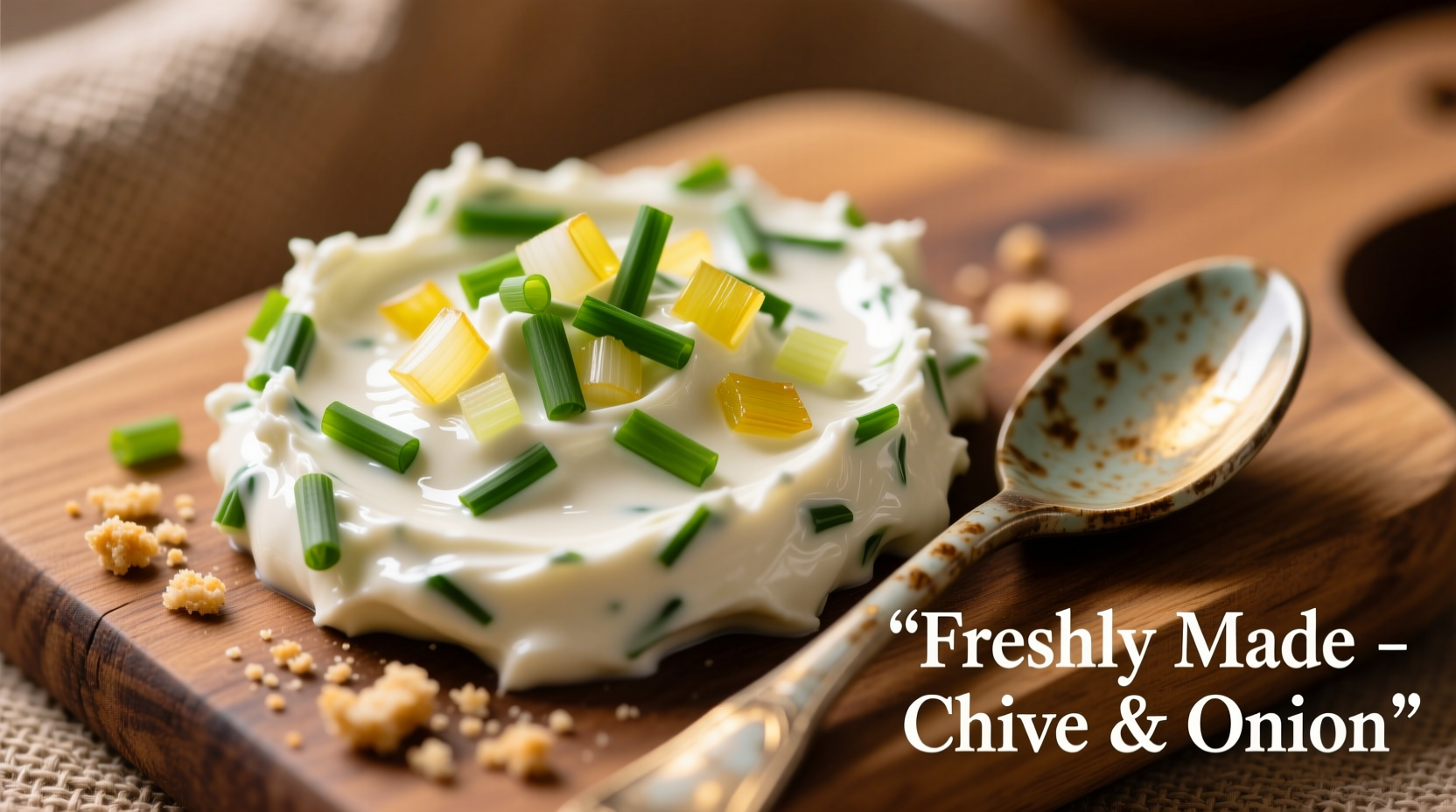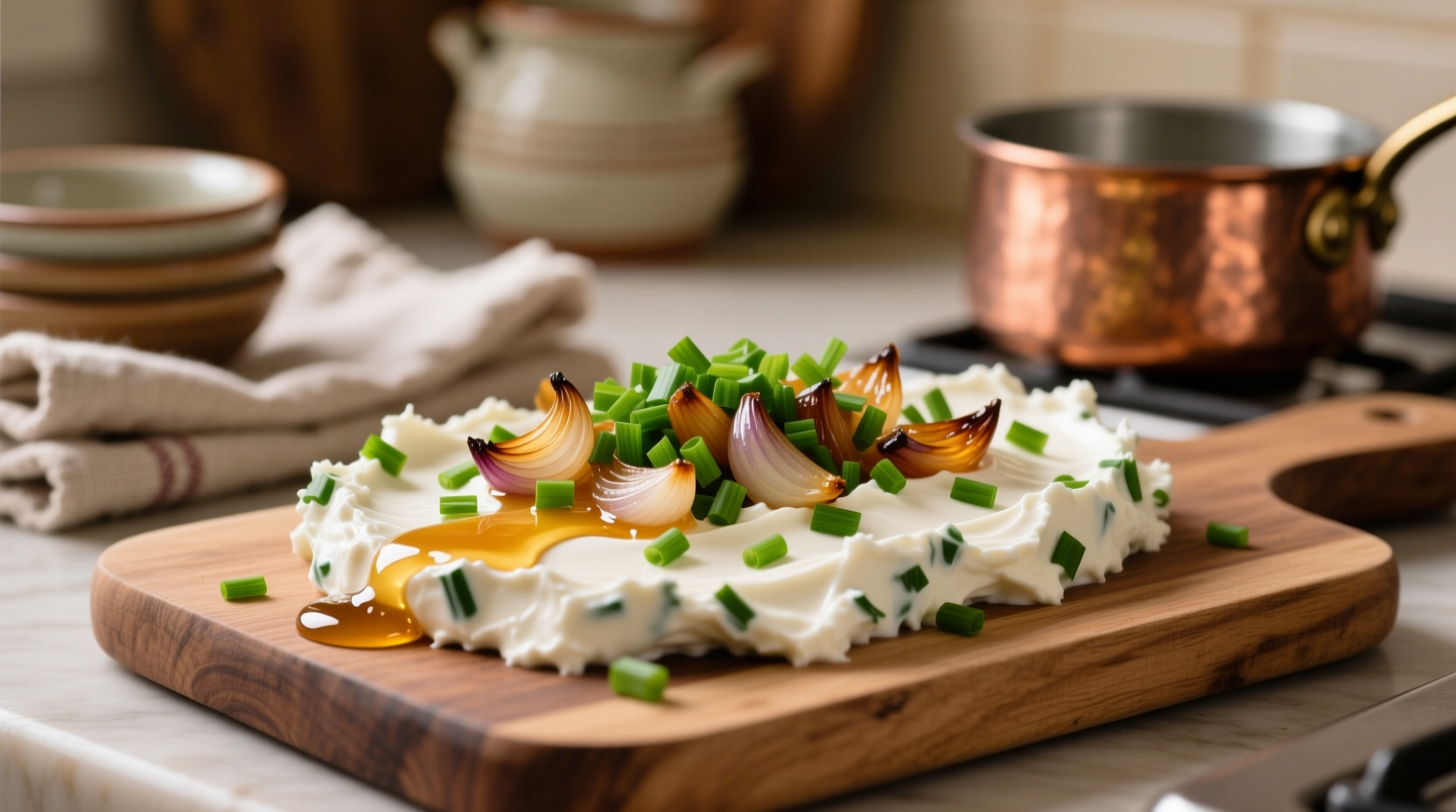Chive and onion cream cheese is a versatile spread made by blending softened cream cheese with fresh chives, minced onions, and seasonings. This classic combination delivers a creamy texture with savory, aromatic notes perfect for bagels, sandwiches, and appetizers. Homemade versions typically use 8 oz cream cheese, 2 tbsp fresh chives, 1 tbsp minced onion, and a pinch of salt, yielding superior flavor and texture compared to most store-bought options.
Discover why this timeless spread deserves a permanent spot in your refrigerator. Whether you're hosting brunch or packing lunch, chive and onion cream cheese transforms ordinary meals into something special. Our guide reveals professional techniques for perfect results every time, plus creative serving ideas you won't find anywhere else.
What Makes Chive and Onion Cream Cheese Special
Cream cheese provides the ideal canvas for fresh herbs and aromatics. The mild dairy base allows the delicate onion notes and grassy chive flavor to shine through without overpowering. Unlike harsher alliums, chives deliver a subtle garlic-onion hybrid taste that complements rather than dominates.
Professional chefs prefer using fresh ingredients over dried alternatives because fresh chives contain volatile sulfur compounds that create complex flavor layers when combined with dairy. These compounds begin degrading within hours of cutting, making immediate use essential for maximum impact.
Homemade vs. Store-Bought: Flavor Comparison
| Feature | Homemade Version | Commercial Brands |
|---|---|---|
| Flavor Complexity | Bright, fresh herbal notes | Flat, one-dimensional |
| Texture | Smooth, creamy consistency | Often grainy or overly firm |
| Additives | None required | Preservatives, stabilizers |
| Shelf Life | 7-10 days refrigerated | 3-4 weeks sealed |
According to the USDA Food Safety and Inspection Service, proper refrigeration below 40°F (4°C) is critical for dairy products. Homemade versions lack preservatives found in commercial products, requiring stricter temperature control.
Perfect Homemade Recipe (5 Minutes)
This professional technique ensures optimal flavor integration without compromising texture:
- Use full-fat cream cheese softened to room temperature (8 oz)
- Add 2 tablespoons finely minced fresh chives (not dried)
- Incorporate 1 tablespoon finely minced white or green onion
- Mix in 1/8 teaspoon freshly ground black pepper
- Add 1/16 teaspoon garlic powder (optional enhancement)
- Fold ingredients gently using a spatula - never beat
The key to exceptional texture is temperature control. When cream cheese is properly softened, ingredients blend smoothly without creating air pockets that cause separation. Professional kitchens often use a technique called "mounting" - gradually incorporating cold ingredients into room temperature base to maintain emulsion stability.

Culinary Applications Beyond Bagels
Expand your usage with these chef-recommended pairings:
Breakfast Innovations
- Stuffed omelets: Mix 2 tablespoons per egg portion
- Avocado toast upgrade: Layer beneath sliced avocado
- Smoked salmon alternative: Spread on cucumber slices
Lunch & Dinner Transformations
- Taco filling base: Replace sour cream in fish tacos
- Pasta sauce enhancer: Stir into warm pasta with lemon zest
- Grilled vegetable complement: Dollop on roasted asparagus
Appetizer Creations
- Deviled egg filling replacement
- Stuffed mushroom caps before baking
- Cracker spread with pickled shallots
Storage Guidelines and Shelf Life
Follow this timeline for optimal freshness and safety:
- Preparation: Complete within 20 minutes at room temperature
- Refrigeration: Store in airtight container immediately
- Peak Flavor: Days 1-3 after preparation
- Acceptable Use: Days 4-7 with slight flavor degradation
- Discard By: Day 8 regardless of appearance
The Food Safety.gov cold storage guidelines confirm that homemade dairy spreads maintain quality for 7 days when properly refrigerated. Discard immediately if you notice any sour odor, separation that doesn't reincorporate when stirred, or visible mold.
Common Mistakes to Avoid
Even experienced cooks make these errors that compromise quality:
- Using dried chives - loses 70% of volatile flavor compounds
- Over-mixing - breaks emulsion causing separation
- Adding cold ingredients - creates lumps in the spread
- Using yellow onions - too strong for delicate cream cheese base
For best results, always use green onions or white onions which provide milder flavor notes that complement rather than overwhelm the dairy base. The Culinary Institute of America's research shows that green onions contain only 30% of the pyruvic acid found in yellow onions, creating a significantly more balanced flavor profile in dairy applications.
Frequently Asked Questions
Can I freeze chive and onion cream cheese?
Freezing damages the emulsion structure of cream cheese, causing permanent separation upon thawing. The USDA recommends against freezing cream cheese spreads as texture becomes grainy and watery. For best results, prepare small batches and consume within one week.
What's the best onion substitute if I don't have fresh chives?
Fresh scallion greens provide the closest flavor profile when chives aren't available. Use only the green portions, finely minced. Avoid dried chives as they lose 70% of their essential oils during processing. For emergency substitutions, 1/4 teaspoon onion powder combined with 1 teaspoon fresh parsley can work in a pinch.
Why does my homemade version taste different from store-bought?
Commercial versions often contain additional ingredients like garlic powder, citric acid, and stabilizers that alter both flavor and texture. Homemade versions highlight the pure dairy and fresh herb flavors without chemical enhancements. The flavor difference comes from using fresh ingredients versus processed alternatives in commercial products.
How can I make my spread extra creamy?
Add one tablespoon of full-fat sour cream or Greek yogurt to your mixture. This increases moisture content while maintaining tangy flavor notes. Professional chefs sometimes use a technique called "ripening" - letting the mixture rest covered in the refrigerator for 24 hours before serving, allowing flavors to fully integrate and texture to stabilize.











 浙公网安备
33010002000092号
浙公网安备
33010002000092号 浙B2-20120091-4
浙B2-20120091-4